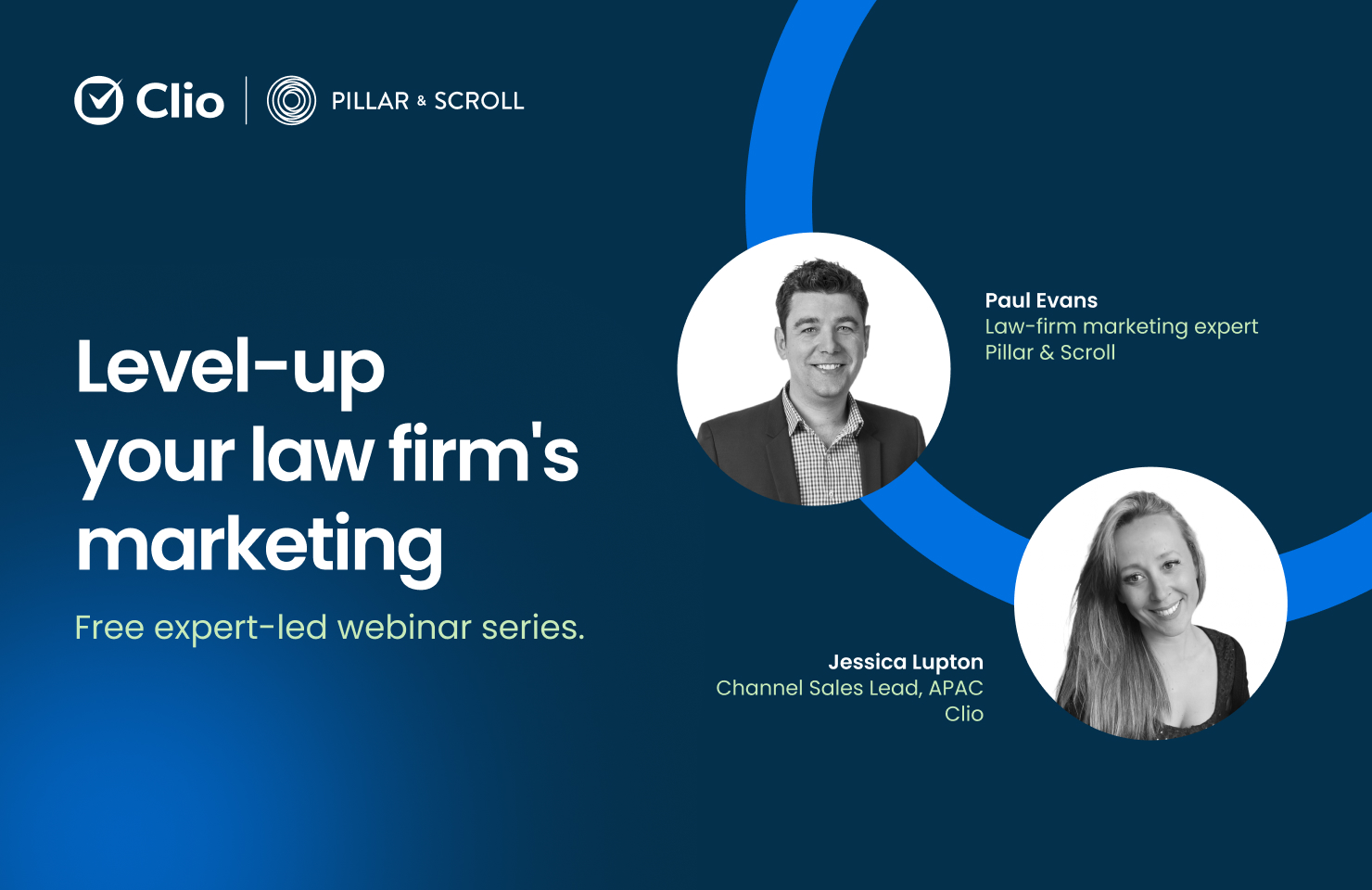Your lawyer profile pages are more important than your homepage
Your lawyers’ profile pages really are more important that the homepage of your website. Collectively, they typically account for most site traffic and are often a huge part of a prospective client’s due diligence process.
By spending some time considering all the information that might be included on the page and crafting unique and engaging content, you’ll help your lawyers position themselves as experts, support their referral process and attract enquiries.
What’s the most important page on a law firm’s website? Hint: It’s not the homepage.
A lawyer’s profile are the most important pages on your firm’s website. Your law firm is selling the value of each individual’s experience and expertise, and your prospects want to know who they will be trusting with their legal issues.
A lawyer’s profile page is the cornerstone of a prospect’s online due diligence. Yes, they want to know about the firm – but more importantly, they want to know who they will be working with.
In my experience, firms often spend more time on their “Services” or “Expertise” pages, and the lawyer profile pages are an afterthought.
After studying the analytics of many law firm websites, we found it should be the opposite case. Typically, we see 3 to 5 visits to a lawyer’s page for every visit to an expertise or services page.
What are the goals for each profile?
A lawyer’s profile page achieves many business goals, including;
- Demonstrating empathy and showing that a lawyer understands the reader’s context and challenges, before a prospect even makes contact.
- Clearly articulating how the lawyer’s experience is different from other lawyers.
- Showing social proof with other client examples, even if they’ve been anonymised.
- Getting a referral to take action and make an appointment with your lawyer.
Your profile structure
A lawyer’s profile page is usually made up of four major sections;
- Summary of experience and expertise
- Photograph and contact details
- Lists of qualifications, memberships, and other relevant information
- A feed from other content on the website
We have also included a section on how to conduct some basic search optimisation for the lawyer’s profile.
Part 1 – Summary of experience and expertise
Unless you are a one-lawyer firm, your profile should be written in the third person. The reader understands the firm is the “owner” of the website, so it makes sense that the lawyer profiles are written about the person, rather than sounding like it’s been written by the lawyer.
Tip: This is contrary to my advice for a lawyer’s LinkedIn profile. This should be written in the first person, as the “owner” of the profile is the individual.
Focus on key differentiators
The key differentiators of a lawyer can be a variety of things, and often are a combination of multiple. We’ll dive deeper into this topic in a future post, but here are some quick ideas for your differentiation.
Sometimes there will be firm-level differentiators. These could include value pricing, type of client, or type of work, like focusing on IP law specifically, or having a unique office location. But here, we’ll focus on examples for the an individual lawyer:
- Demonstrated experience in a specific industry. In our experience working with law firms, this works especially well with commercial law firms. Business clients love knowing that their lawyers understand their industry or problems.
- Multiple languages spoken. This can be a game-changer if it matters to your client.
- Experience working in the industry prior to becoming a lawyer. For example, an employment lawyer who used to be a HR manager understands their audience’s pain points, because they have lived and breathed it.
- Previous experience as an in-house lawyer. Especially if your ideal clients are General Counsel and in-house teams.
For example, our key differentiators are:
- We’ve lived in our client’s shoes, having been marketing managers in some of the fastest-growing law firms in Australia.
- We have digital technical expertise, while also understanding how to apply it in a relationship marketing context.
Examples of experience
Nothing conveys trust more than actual experience.
If your lawyers specialise in helping clients in a certain industry, or their cases are confidential or private in nature, it can be difficult to articulate experience without giving too much information away.
Obviously, the more you can share – the better, but if details need to be anonymised then that’s better than not including any information at all.
Here are some examples of experience you may want to include:
- The names of organisations or high profile individuals
- The value of deal sizes (M&A, property, settlements, etc)
- Unexpected, but favourable outcomes
- The number of matters (if it’s relatively substantial)
- Testimonials from clients / referrers
Draft an excerpt / summary
The “excerpt” is an optional feature of a number of content management systems. It’s typically 1-2 sentences and is a summary or description of the page. Its main use is that it will feed through to other parts of the website.
For example, an excerpt may be re-used at the end of your blog as an author biography or in your index page for all your lawyers.

Tip: For consistency and ease, you could also use the excerpt copy in each lawyer’s meta description (read more about this in the SEO section below).
Consider whether to include personal information
There’s an ongoing debate between marketing professionals about whether to include personal information on a lawyer’s profile page.
Our perspective is that it’s entirely dependent on the firm’s culture and positioning.
For example, if your target audience is in-house counsel at large financial services firms, telling the reader about your two dogs seems weird.
However, if you’re a NewLaw firm, everyone works remotely from a home office, and your clients are local family-run businesses, it can make sense to mention your family and generations of business owners. It’s relevant and shows you can emphasise with your audiences’ business.
If you’re a personal injury law firm and you talk about activities you partake in, it may seem insensitive. However, if you’re a family lawyer and you have children – a reader who is going through a separation and also has children may emphasise with that.
It all comes down to WIIFM (What’s in it for me?). Why should the reader care?
Tip: Before writing your lawyer profiles, make sure you answer the question: who are your lawyer’s ideal reader/s?
Terms to avoid in profiles
There’s an entire movement about using plain English. It typically picks on lawyers and their use of legalese in legal documentation.
When it comes to marketing copy for lawyers, I am a strong believer that you should use jargon – but only in the context of it making sense to the reader. For example, if you work with financial regulators, it’s actually important that you use their terminology for things. Don’t dumb it down.
Having said this, lawyers’ online profiles are often laden with cliches. Whilst they can be difficult to avoid in some circumstances, it’s worth being aware that these terms appear throughout the web a lot.
- significant / substantial / particular experience
- act for many / advises on a wide range of / assists a diverse range of
Be specific. It’s what will set your lawyers apart from the rest.
I also recommend avoiding phrases that should be a “given” for any lawyer:
- Tailor their approach
- Easy to work with
- Responsive to deadlines
- Take pride in work
- For litigators, “regularly appearing in courts and tribunals” is not particularly unique.
- Eye for detail
If anyone can claim it, or if the opposite is terrible (for example, not responsive to deadlines), don’t include it.
Part 2 – Photograph and Contact Details
A professional photograph
Although smartphone cameras are getting better, a professionally taken photograph sets the tone of your lawyer’s profile page, and should go without saying. Your lawyers are the “product” that your firm is selling.
Based on our experience working with firms that have multiple locations, we recommend keeping your style simple. It’s more cost effective to have a style that local photographers can replicate, unless you plan to send one photographer to each office.
Tips for your lawyer’s photographs
- Keep the background as simple as possible. If you recruit more lawyers, or your regular photographer becomes unavailable for some reason, you want to be able to replicate the same style as easily as possible.
- Update the photography every few years, as people tend to age!
- Where possible, use a photographer that has access to a studio near your office. This can be a handy and more economical if you have a small batch of photographs that need to be taken (new recruit, reshoot, etc). The lawyers can travel to the studio and be in and out in an hour or so.
- Make sure the photographs will work when reduced in size (for example, on LinkedIn profiles, event programs, etc.)
Professional photography is a necessary cost of doing business for law firms.
Contact Details
The most common question I get from law firms around contact details is: “What should I include?”
Here is my summary for the most common contact details to provide online:
Direct Office Number
As a general rule, include the direct office number of a lawyer on the profile page. At most firms we have worked with (in-house and as an agency), a legal secretary or receptionist will often pick up the line and announce the call anyway. It looks strange and impersonal when everyone’s phone number is the same reception line… especially if your lawyers are presented in a list.
Mobile Phone Number
There is a risk of random callers, telemarketers, and other scams when you publish your mobile number online. While it is possible, we haven’t gotten this complaint from law firms in our experience. Our senior team has mobile numbers on their profile pages.
From a potential client perspective, you want to answer “how accessible is this lawyer?” Typically, firms will have a “rule” for their website. For example, all Partners will have their mobile numbers listed on the site, but not Senior Associates and Lawyers. Some firms will have all, some won’t. Examine the pros and cons in your scenario.
Email Address
Include an email address in your lawyers’ profile pages. Many prospects prefer email over a phone call when getting in touch, as it gives them time to craft and review their message.
Although revealing your email address can open up the risk of spam, most spam can be blocked by email filters that your IT professionals have set up.
Social profiles
We say add links to your social profiles, especially LinkedIn. Below is a general guide for the most popular social media profiles.
- LinkedIn – Yes, and keep your profiles updated.
- Twitter – Only if it’s a work account.
- Facebook – It’s likely to be irrelevant.
Generally, include links to your lawyers’ work-related social profiles, but not their personal ones.
Other contact information
Think about other ways your lawyers might want to be contacted, that is relevant to your firm. We’ve occasionally seen lawyer profiles with links to instant messaging services such as WeChat.
If you have multiple offices, include the location of the lawyer’s primary office.
Avoid adding outdated communication methods like Fax.
Including the lawyer’s assistant’s name and direct line can also be a good idea – but again, it depends on the culture and goals of each firm.
Part 3 – Lists of qualifications, memberships and other relevant information
In Australia, we suffer from “tall poppy syndrome.” I’ve heard many lawyers argue that less is more when talking about themselves, to avoid being seen as “bragging.”
When it comes to lawyers’ profile pages, your firm is responsible for touting their expertise. It will be written in third person, creating a layer of separation from the lawyers themselves listing off their accomplishments.
In a lawyer’s profile page, the entire value proposition relies on the reader trusting your lawyer and your firm. Communicating experience and unique points of difference is all in the name of building credibility, which leads to trust.
You need to tell people about your lawyers’ achievements and experience. If you don’t, no one will.
Tip: Adding a unique qualification or membership can help create a talking point for your reader to ask your lawyer about.
Qualifications
Everyone assumes that a lawyer has a law degree, but listing out their qualifications shows that your lawyers are a skilled set of hands. Many lawyers also have a second degree (i.e. Commerce, Arts, etc) and some have post-graduate qualifications or Accredited Specialisation.
Should you include the university and the year of graduation? That’s your call. It’s worth noting that this information will typically be on your lawyers’ LinkedIn profiles anyway, if they’re completed properly.
Professional Memberships
Add your lawyer’s relevant professional memberships.
For example, if you’re writing a profile for a property lawyer, adding that you are a member of the Property Council of Australia is logical.
Adding that you’re a member of a football team… not so much!
Board memberships
This section may include businesses, charities, and other professional organisations. If they are appropriate to your position as a lawyer, or help position the lawyer in a positive light, then include them in the lawyer profile page.
Are they on the committee of their child’s soccer team? You can skip that.
Languages
Although English fluency is assumed in Australia, if your lawyers can speak a second language it can be a huge point of differentiation. This is definitely worth adding – but only if the lawyer is fluent.
Awards
If your lawyers have received relevant awards recently (within the past 2 years), add them. This section can include Chambers, Legal 500, AFR, or industry-specific awards.
We know how long those submissions take, you should make the most of them by adding them to your website.
External publications
If your lawyers have written or been featured in an external publication (that’s relevant), this should be added to their profile. It’s a quick and easy way to convey their expertise and is excellent social proof to demonstrate thought leadership in a specific area.
Feeds from other sections of the website
One of the most common ways a user finds a law firm website is to search for the lawyer’s name online, then click through to the lawyer’s profile page.
The content mentioned above is critical information for the user. However, one of the best methods of communicating that the lawyer is an expert in their niche is to include feeds of information from other parts of the website.
Common feeds and related information might include:
- Related expertise
- Related industry focus
- Thought leadership articles
- Events that the lawyer is hosting
- Related firm news
- List of relevant awards
- Other lawyers in their team or with similar expertise
Basic search engine optimisation (SEO) considerations for your lawyer’s profile pages
Here are some SEO considerations specific to lawyer’s profile page:
Their name must be in Heading 1 format
The “Heading 1” on your lawyer’s profile page must be their name and should be the only “Heading 1” on the page.
You should be able to work this out in your firm’s content management system (i.e. WordPress, Umbraco, etc.)
The page title should have the basics
The page title should include your lawyer’s name, their area of expertise (industry or technical) and the firm name.
This is what will appear in Google when someone searches for your lawyer’s name. You want to make it as clear as possible when people have been referred to your lawyer and a prospect searches for them.
The copy that you place in the title is typically honoured by Google, but there are exceptions and instances where this isn’t always the case.
Include more detail in the meta descriptions
The meta description is where you can go into more detail and give the user a reason to click through to learn more about your lawyer.
The page should have its own URL that includes the lawyer’s name
It’s important that the profile page has a unique URL, such as firmname.com.au/people/jane-doe/
This is important from an SEO perspective, but also a user experience one. You don’t want the prospect searching for the person on Google and then being directed to a page on your website where they have to look for the profile they want.
Here are a few additional quick tips:
- Word Count – Ensure your lawyer’s profile summary is 300 words or more.
- Use internal linking – Include links to relevant areas of expertise, industry pages and thought leadership posts. This not only helps your SEO, it helps the user navigate through connected content on your website. A feed of thought leadership posts and relevant news helps keep the page fresh.



